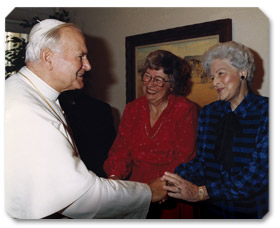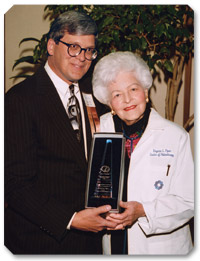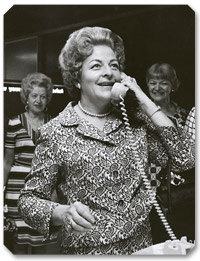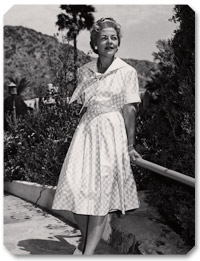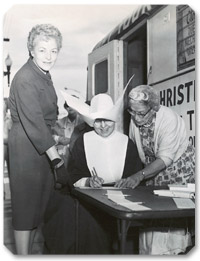|
CHAPTER FIVE In 1975, as Virginia G. Piper was privately coping with the death of her second husband, a renewed feminist movement,catalyzed in 1970 by the fiftieth anniversary of the passage of the Nineteenth Amendment, which granted women the right to vote,was in full exhilarating momentum. That year, more than three hundred feminist rallies and demonstrations on behalf of women's rights were held nationwide, and Congress, aware that half of its voting constituency consisted of women, passed legislation on behalf of women's rights with uncharacteristic and cooperative speed. This new wave of feminism was making an impact within the social institution of the family, in education, religion, the workplace, and in courts of law. Over 50 percent of American women with children were employed outside the home, yet a rising divorce rate feminized the face of poverty as single mothers struggled to raise their children on disproportionately low wages. The following year, on July 4, America celebrated its bicentennial birthday; later that summer, the Olympic Games were held in Montreal. In November 1976, Democrat Jimmy Carter was elected president of the United States, replacing Gerald Ford, and in 1977 Alex Haley's Roots aired as an ABC miniseries, drawing a record 80 million viewers, while in Paris the newly opened modern art museum, The Pompidou Center, provoked rancorous controversy. On Broadway that same year, New York, New York and Annie scored long-running hits, music icons Elvis Presley and Bing Crosby died, and the death of Charlie Chaplin unofficially marked the end of the silent film era. In 1977, the Nobel Peace Prize was awarded to Amnesty International, a London-based organization working peaceably on behalf of prisoners of conscience throughout the world, and the world was waking slowly to news of unprecedented species extinction and warnings of vast ecological compromise. Within the context of a vibrant feminist movement, a bicentennial celebration of America's history, and an emerging awareness of environmental crisis and heightened sensitivity to world peace, Virginia Piper, who in 1975 was sixty-three and widowed a second time, would begin to move into the most productive and independent decades of her humanitarian service. The philanthropic legacy she single-handedly created, initially founded on work she had accomplished through the Paul V. Galvin Charitable Trust, would eventually impact to an astonishing degree the future of rapidly developing Maricopa County. If what St. Teresa of ovila once said is true, that "suffering is the swiftest route to the Beloved," then Virginia's personal anguish over the unexpected loss of Ken Piper may have brought her even closer to her spiritual faith, propelling her into a shining final chapter of prodigious achievement and an era of unparalleled giving by a woman who consciously chose selflessness as her highest response to personal affliction. While Virginia Piper's talents and skills had been influenced and developed under the supporting mentorship of both her husbands, her character was rooted in her native intelligence and her family's loving Midwestern values. At sixty-three, she charted a philanthropic path that was the culmination of her life experiences and flowered from all the support and guidance she had received from Paul, Ken, and her family. Possibly like no other woman of her era, Virginia was completely adept, trained, and intellectually and spiritually equipped to become a new kind of philanthropist-an engaged, modern philanthropist. The young woman who had once dreamt of being a writer-the woman who still "tape-sponded" with friends and family and who beautifully and lyrically wrote all her personal and business letters-knew the power of language and communication. She understood that as a philanthropist she could, as an artist would, articulate a vision and oversee its execution and thereby craft an everlasting legacy with ultimate impact. Imagine a woman who could have easily retired from life becoming single-handedly a one-woman CEO and CFO of a new enterprise devoted to improving the quality of life for Maricopa County citizens. Though it would be years later that the trustees of The Virginia G. Piper Charitable Trust would officially designate Maricopa County as the beneficiary of Virginia's estate, Virginia determinedly set the course for this future. Though Virginia had advisors and consultants, it is quite clear that she, who valued professionalism, made a conscious decision to redefine charitable giving by being actively and intimately involved in all her philanthropy. This approach was unique for the era, rare among women, and foreshadowed the donor-engaged and directed philanthropy of the twenty-first century. Imagine a woman who had lost two husbands and who never reared biological children reaffirming that community values, akin to family values, meant embracing people, nurturing a healthy society, and delighting in giving. Virginia was an astute businesswoman who rejoiced in philanthropy. As a savvy professional, she never neglected interpersonal and personal relationships. Her philanthropy wasn't just professional expression, but it was also the epitome of humanistic expression. Virginia said, "People give to people." Imagine a fiercely independent woman settling in a western state experiencing explosive growth and innovation. Virginia loved her adopted Arizona home, and it may well have been that the West, with its open horizons and ever-expanding possibilities, resonated with Virginia's desire to be liberated from traditional philanthropic giving and from the demeaning stereotype of women adding grace but little intellectual leadership to charitable giving. Virginia, without question, had matured into a powerful, visionary, and effective leader. The term "living room philanthropist," as fondly applied to Virginia, derived from the fact that countless people working on behalf of one charity or another found themselves discussing project proposals while seated in her living room, for just as Virginia delighted in sitting with close friends around a kitchen table, she liked to conduct business from the comfort of her home. Handwritten checks in generous amounts frequently emerged from these living-room discussions. It was Virginia, in her quest for exactitude and excellence, who judged the merits of every request and, amazingly, wrote and typed all her professional correspondence. Virginia would type, "My board has considered your request," but Virginia was the board, just as she was "kb," Kitty Brandleknees, the secretary typing hundreds of business letters on her manual Royal typewriter. Virginia worked long hours-often late into the night and seated at a huge desk in her homey but cluttered office-with her beloved cat, Gus, keeping her company as he reclined among her papers, napping on unanswered letters. She answered dozens of phone calls and piles of correspondence daily and attended a constant round of meetings and charity events. Because of the extent of her wealth and the depth and breadth of her charitable contributions, Virginia Piper's public prestige was tremendous. Worthy but incessant requests for monetary aid had to be answered with discernment, so Virginia's financial acumen, common sense, and nearly intuitive ability to sort through massive correspondence became crucial factors in her decision process. |
|
| About the Author l Pipertrust.org | |








